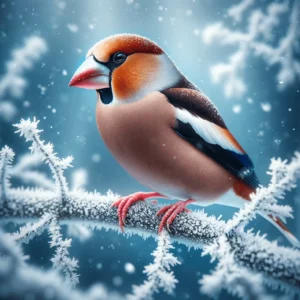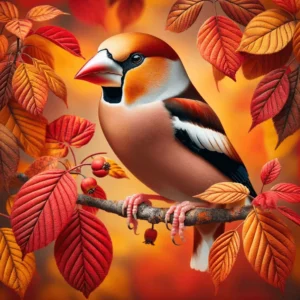For birdwatchers seeking a captivating species to observe, the hawfinch should be at the top of their list. With its majestic appearance and unique feeding behavior, the Coccothraustes is a true birdwatcher’s gem.
Found primarily in woodland habitats, this enigmatic bird embodies grace and beauty in the natural world. Its feeding behavior sets it apart from other birds, making it a fascinating species to observe and study.

Key Takeaways:
- Coccothraustes is a captivating species for birdwatchers to observe.
- Woodland habitats are where Coccothraustes flourish.
- The Coccothraustes has a unique feeding behavior that makes it stand out from other birds.
Habitat and Conservation of the Hawfinch
Coccothraustes is a bird species known for its habitat preferences and conservation needs. This bird thrives in woodland habitats found in Europe and Asia, where it can nest and breed during the spring and summer.
The Coccothraustes population has been declining in recent years due to habitat loss caused by deforestation, human development, and climate change. Conservation efforts have been implemented to protect this remarkable bird species and prevent further population decline. Such initiatives include habitat restoration and protection plans that aim to restore the integrity of the natural ecosystems where the Coccothraustes live.
| Conservation Efforts | Population Trends |
|---|---|
| Implementing habitat protection plans and restoration efforts | Declining population due to habitat loss and fragmentation |
| Creating national parks and nature reserves for Coccothraustes conservation | Low reproductive success rates linked to habitat degradation |
| Developing public awareness campaigns to promote Coccothraustes conservation | Conservation efforts show positive results in certain areas |
It is essential to continue raising awareness about the importance of preserving the Coccothraustes’s habitat and the benefits of conservation efforts to ensure the survival of this captivating bird species for future generations.
The Remarkable Features of the Coccothraustes
Coccothraustes is a bird species highly admired for its unique physical characteristics. With its robust beak and vibrant plumage, it stands out from other bird species. Its beak is more powerful than any other finch’s beak and allows it to crack open larger seeds. Its head is large, and its neck is short and thick. The Coccothraustes’s wingspan can reach up to 33cm, and its weight can range from 44 to 71 grams.
The Coccothraustes’s plumage, or feathers, vary by gender and age. Males have brighter and more intense colors, while females have softer and duller colors. Their feathers can be a mix of brown, black, white, and orange, and their patterns vary from streaked to spotted. The color of their plumage is essential in Coccothraustes courtship displays, indicating good health and genetics.
The word hawfinch has its origins in the Old English word “haga,” meaning hedgerow, and the word “finch.” The name reflects the bird’s preference for dwelling in woodland habitats with hedgerows and thickets, where it can feed on the fruits and seeds of trees, shrubs, and herbs.
Feeding Habits and Favorite Food of the Coccothraustes
The coccithraustes feeding habits are a true wonder to behold. With their unique beak adaptation, they are skilled at consuming a wide variety of seeds and fruits. It is their robust beak that allows them to crack open even the toughest of shells, making their feeding habits a true spectacle to observe.
Their favorite food is primarily made up of hard seeds, such as cherry stones, and the seeds they consume can be up to 1cm in length! Their diet also includes fruits, buds, and small insects, making for a varied and balanced diet.

Comparison of Coccothraustes’s Feeding Habits
| Food Type | Consumption Rate |
|---|---|
| Cherry stones (favorite food) | Average consumption of 150 per day per bird |
| Other hard seeds | Up to 40 seeds per minute when feeding |
| Fruits and buds | Up to 20% of daily diet |
| Small insects | Occasional consumption for added protein |
The Coccothraustes’s feeding habits are not only unique but crucial for their survival. Their ability to consume hard, difficult-to-reach foods makes them a vital species in woodland ecosystems and highlights the importance of their conservation.
If you want to observe their remarkable feeding behavior, keep an eye out for them in woodland areas where their preferred food sources can be found.
Observing the Hawfinch: Best Time and Locations
For birdwatchers eager to spot the elusive Coccothraustes, timing and location are key. The best places to see Coccothraustes are woodland areas, where they thrive in their natural habitat. Some locations to consider in Europe are the Białowieża Forest in Poland, Adrspach-Teplice Rocks in the Czech Republic, and Parco Naturale delle Orobie Bergamasche in Italy.
The best time to see Coccothraustes is during the winter months, when they gather in larger flocks to feed on seeds and fruits. In Japan, coccothraustes are most visible in January and February, while in Europe, the ideal time is between December and March.
To increase your chances of spotting these majestic birds, arrive at your chosen location early in the morning or late in the afternoon, when coccothraustes are most active. Remember to stay quiet and still, as these birds can be easily frightened away.
Conclusion
In conclusion, the hawfinch is a truly remarkable bird species that continues to capture the attention of birdwatchers and bird enthusiasts alike. Its majestic appearance, unique feeding behavior, and vibrant plumage make it a gem among birds. However, it is important to note that the Coccothraustes population is facing conservation challenges, highlighting the need for continued efforts to protect and preserve this species. By appreciating the beauty and uniqueness of the hawfinch, we can contribute to its conservation and ensure that future generations can witness the birdwatching allure of this captivating species.
FAQ
How rare is a hawfinch?
The Coccothraustes is considered a fairly rare bird species, with a scattered distribution across Europe and Asia.
What are some interesting facts about the Coccothraustes?
The Coccothraustes is known for its robust beak, vibrant plumage, and unique breeding behavior. It is also called the “bulldog” among birdwatchers due to its sturdy appearance.
What is a Coccothrauste’s favorite food?
The Coccothraustes’s favorite food includes hard seeds, such as cherry pits and hornbeam nuts. It also feeds on berries and insects when they are available.
What is the origin of the word coccothraustes?
The word “hawfinch” is believed to be derived from the Old English words “haga” and “finc,” meaning “grove” and “finch,” respectively.
Do coccothraustes migrate?
While some Coccothraustes populations are migratory, others are resident, staying in their preferred habitats year-round. Migration patterns can vary depending on geographical location.
Does a Coccothraustes have teeth?
No, Coccothraustes do not have teeth. However, their beaks are exceptionally strong and sturdy, allowing them to crack open hard seeds and nuts.
Where is the best place to see Coccothraustes?
The best places to see Coccothraustes are usually in woodland areas, including large forests and mature deciduous woodlands.
What is the best time to see hawfinches?
The best time to see Coccothraustes is during the breeding season, which typically occurs from late spring to early summer. This is when they are most active and vocal.
